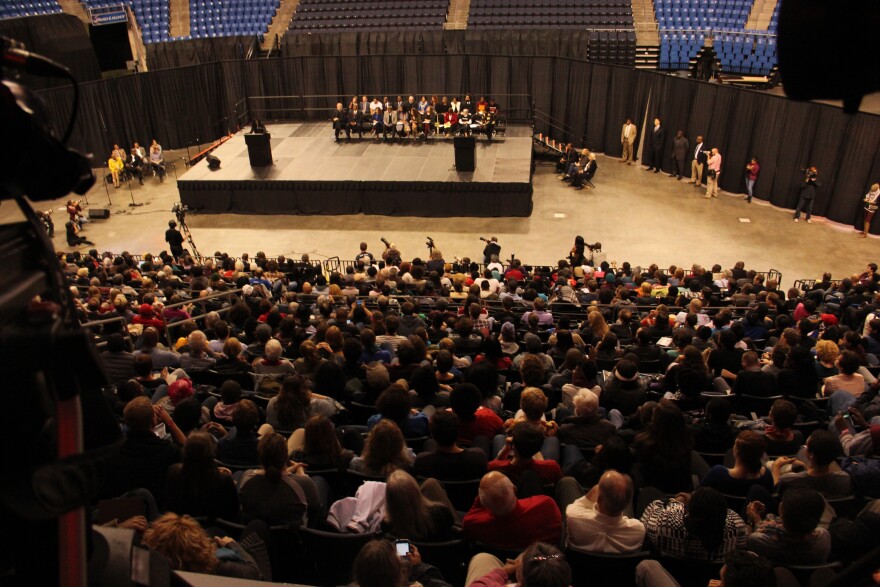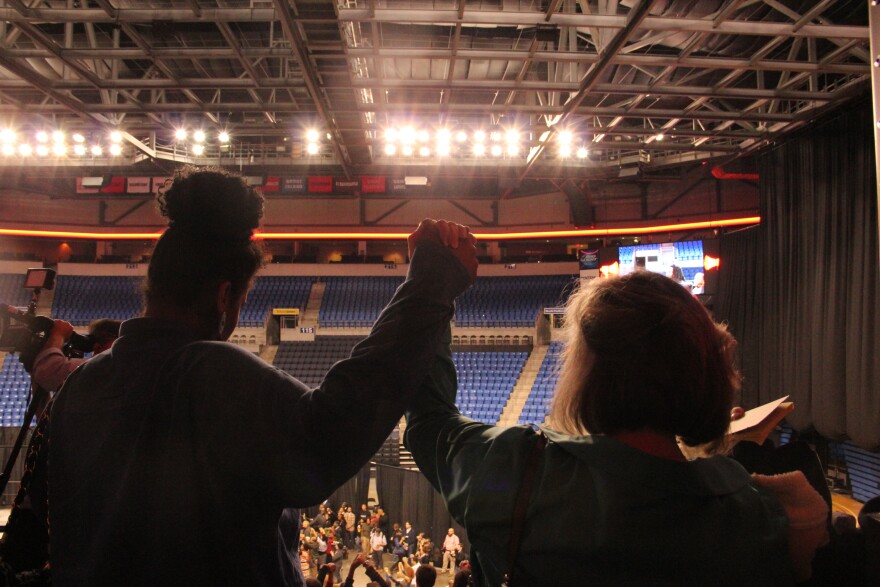The Rev. Traci Blackmon of Christ the King United Church of Christ took to the podium as the MC during a mass meeting on Sunday night. In her opening remarks to a crowd of thousands gathered in Saint Louis University’s Chaifetz Arena, she echoed the sentiment of Rev. Osagyefo Sekou, who spoke before her.
“It is the young people that have moved this movement forward,” Blackmon said.
Then, about half way through the meeting, young people in the crowd demanded that they take the stage alongside prominent faith leaders. A group of people in their early 20s spontaneously stood up and began shouting at the stage, some turned their backs during a speech by NACCP President Cornell William Brooks.
Initially it was hard to make out what was being shouted, but the crowd erupted into a chants of “let them speak” and “this is what democracy looks like!”

Blackmon then invited them to take a seat on stage and speak their mind. She turned to previously scheduled speakers and apologized for the change in schedule, then added: “This is what democracy looks like.” The crowd erupted in cheers.
“Look at all the people here,” said one young protester. “Now imagine if you all were on the street. Is that too much, or are you all too scared?”
Another young woman said it’s time make plans for what happens next
“We need to strategize before we get out there so things don’t fizzle out like they always do,” she said.
The young woman asked the crowd, “whose streets?”
“Our streets!” came of chorus replies from the crowd.
“And don’t you forget it,” she said.
Tef Poe was already scheduled to speak. The St. Louis rapper in his mid-20s echoed what other young people had to say on Sunday evening.
“We’re not professional activists,” he said. “We’re just real people who identified a problem and decided to go do something about it.”
“This ain't your daddy’s civil rights movement. They want to know when we’re going to go back in the house. We ain't never going to go back in the damn house.”
Dennis Black, a 23-year-old from Detroit, said he’s been to Ferguson twice and is sleeping near the memorial for Michael Brown in the Canfield Green Apartment Complex. He had this to say about many of the older speakers:
“It’s the same narrative spoken over and over, it’s the same political talking points,” Black said. “These are designed speeches known to get the crowd going. To carry the age old trope of the charismatic leader. It’s those same, aged out politics where it’s not effective anymore.”
Meeting at a sports arena on a college campus, Black said, isn’t the best venue for protest.
“This would have had a lot more meaning if this was in Canfield, if this was on West Florissant,” Black said.
Young people have fueled many of the protests that brought international attention in the wake of Ferguson Police Officer Darren Wilson fatally shooting unarmed 18-year-old Michael Brown on Aug. 9. Black said there remains a chasm between young people protesting and older, established civil rights leaders. But when young people’s voices are heard, as they were on Sunday night, the gap begins to narrow.
“The challenge is going to be, can we create some kind of coming together of the old school and the new school,” said keynote speaker Dr. Cornel West. “Of the older generation and the newer generation. The younger generation has felt so disrespected for so long. And one of the reasons is the larger system has been viciously coming at them.”
Marching, Game Theory

Some of the same young people who spoke at the meeting at the Chaifetz Arena organized marches later in the evening. The demonstrators split into two groups. One marched back to The Grove in the general area the march had ended the previous day but turned west onto Chouteau Avenue and on to Manchester Avenue. In this entertainment area, the members of the group blocked intersections and jumped rope, played soccer and hopscotch. But the games, organizers said on twitter, were played to make the statement that these protests are not games.
The exuberance in The Grove was in contrast to the other group, which marched in silence. The two met up on Grand Boulevard, and for a while there was a standoff with police, who were clanging batons on the street and dressed in riot gear. However, the marchers by and large stayed on the sidewalk and were allowed to continue walking to the north.
The group entered into the Saint Louis University campus, where they encouraged students to join them. Amid speeches and chants, all became silence for four minutes in recognition of the death of Vonderrit Myers Jr., who was killed after a confrontation with an off-duty police in the Shaw neighborhood. The police say Myers fired a gun first.
One person who was live-streaming the march and action at the university estimated that the crowd amounted to several hundred. People on twitter noted that it had grown throughout the evening.





